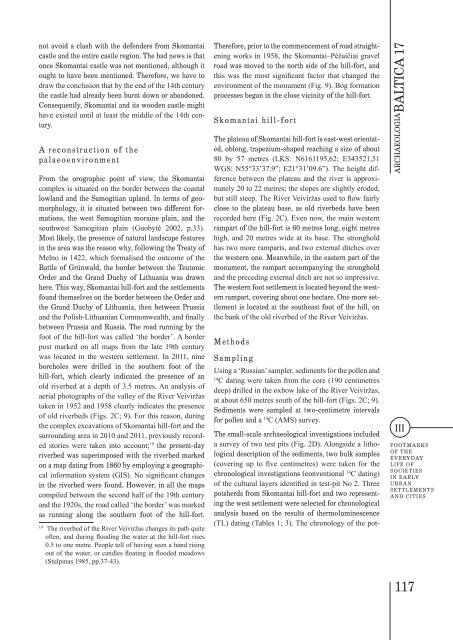BALTICA17 - KlaipÄdos universitetas
BALTICA17 - KlaipÄdos universitetas
BALTICA17 - KlaipÄdos universitetas
Create successful ePaper yourself
Turn your PDF publications into a flip-book with our unique Google optimized e-Paper software.
not avoid a clash with the defenders from Skomantai<br />
castle and the entire castle region. The bad news is that<br />
once Skomantai castle was not mentioned, although it<br />
ought to have been mentioned. Therefore, we have to<br />
draw the conclusion that by the end of the 14th century<br />
the castle had already been burnt down or abandoned.<br />
Consequently, Skomantai and its wooden castle might<br />
have existed until at least the middle of the 14th century.<br />
A reconstruction of the<br />
palaeoenvironment<br />
From the orographic point of view, the Skomantai<br />
complex is situated on the border between the coastal<br />
lowland and the Samogitian upland. In terms of geomorphology,<br />
it is situated between two different formations,<br />
the west Samogitian moraine plain, and the<br />
southwest Samogitian plain (Guobytė 2002, p.33).<br />
Most likely, the presence of natural landscape features<br />
in the area was the reason why, following the Treaty of<br />
Melno in 1422, which formalised the outcome of the<br />
Battle of Grünwald, the border between the Teutonic<br />
Order and the Grand Duchy of Lithuania was drawn<br />
here. This way, Skomantai hill-fort and the settlements<br />
found themselves on the border between the Order and<br />
the Grand Duchy of Lithuania, then between Prussia<br />
and the Polish-Lithuanian Commonwealth, and finally<br />
between Prussia and Russia. The road running by the<br />
foot of the hill-fort was called ‘the border’. A border<br />
post marked on all maps from the late 19th century<br />
was located in the western settlement. In 2011, nine<br />
boreholes were drilled in the southern foot of the<br />
hill-fort, which clearly indicated the presence of an<br />
old riverbed at a depth of 3.5 metres. An analysis of<br />
aerial photographs of the valley of the River Veiviržas<br />
taken in 1952 and 1958 clearly indicates the presence<br />
of old riverbeds (Figs. 2C; 9). For this reason, during<br />
the complex excavations of Skomantai hill-fort and the<br />
surrounding area in 2010 and 2011, previously recorded<br />
stories were taken into account; 19 the present-day<br />
riverbed was superimposed with the riverbed marked<br />
on a map dating from 1860 by employing a geographical<br />
information system (GIS). No significant changes<br />
in the riverbed were found. However, in all the maps<br />
compiled between the second half of the 19th century<br />
and the 1920s, the road called ‘the border’ was marked<br />
as running along the southern foot of the hill-fort.<br />
19<br />
The riverbed of the River Veiviržas changes its path quite<br />
often, and during flooding the water at the hill-fort rises<br />
0.5 to one metre. People tell of having seen a hand rising<br />
out of the water, or candles floating in flooded meadows<br />
(Stulpinas 1985, pp.37-43).<br />
Therefore, prior to the commencement of road straightening<br />
works in 1958, the Skomantai–Pėžaičiai gravel<br />
road was moved to the north side of the hill-fort, and<br />
this was the most significant factor that changed the<br />
environment of the monument (Fig. 9). Bog formation<br />
processes began in the close vicinity of the hill-fort.<br />
Skomantai hill-fort<br />
The plateau of Skomantai hill-fort is east-west orientated,<br />
oblong, trapezium-shaped reaching a size of about<br />
80 by 57 metres (LKS: N6161195,62; E343521,51<br />
WGS: N55°33’37.9”; E21°31’09.6”). The height difference<br />
between the plateau and the river is approximately<br />
20 to 22 metres; the slopes are slightly eroded,<br />
but still steep. The River Veiviržas used to flow fairly<br />
close to the plateau base, as old riverbeds have been<br />
recorded here (Fig. 2C). Even now, the main western<br />
rampart of the hill-fort is 60 metres long, eight metres<br />
high, and 20 metres wide at its base. The stronghold<br />
has two more ramparts, and two external ditches over<br />
the western one. Meanwhile, in the eastern part of the<br />
monument, the rampart accompanying the stronghold<br />
and the preceding external ditch are not so impressive.<br />
The western foot settlement is located beyond the western<br />
rampart, covering about one hectare. One more settlement<br />
is located at the southeast foot of the hill, on<br />
the bank of the old riverbed of the River Veiviržas.<br />
Methods<br />
Sampling<br />
Using a ‘Russian’ sampler, sediments for the pollen and<br />
14<br />
C dating were taken from the core (190 centimetres<br />
deep) drilled in the oxbow lake of the River Veiviržas,<br />
at about 650 metres south of the hill-fort (Figs. 2C; 9).<br />
Sediments were sampled at two-centimetre intervals<br />
for pollen and a 14 C (AMS) survey.<br />
The small-scale archaeological investigations included<br />
a survey of two test pits (Fig. 2D). Alongside a lithological<br />
description of the sediments, two bulk samples<br />
(covering up to five centimetres) were taken for the<br />
chronological investigations (conventional 14 C dating)<br />
of the cultural layers identified in test-pit No 2. Three<br />
potsherds from Skomantai hill-fort and two representing<br />
the west settlement were selected for chronological<br />
analysis based on the results of thermoluminescence<br />
(TL) dating (Tables 1; 3). The chronology of the pot-<br />
ARCHAEOLOGIA BALTICA 17<br />
III<br />
FOOTMARKS<br />
OF THE<br />
EVERYDAY<br />
LIFE OF<br />
SOCIETIES<br />
IN EARLY<br />
URBAN<br />
SETTLEMENTS<br />
AND CITIES<br />
117

















